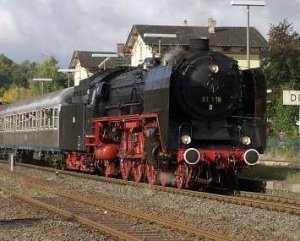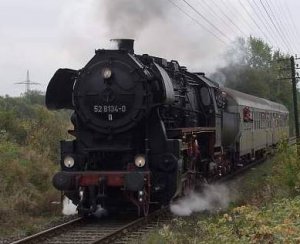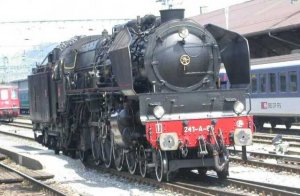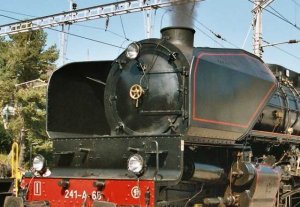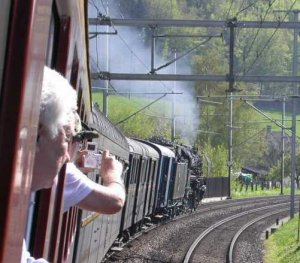While watching some of those documentaries, some of the steam engines have what I would refer to as "blinders". You know, those things you put on a horse when you don't want them looking anywhere except straight forward? Well, the steam engines have these big flat panels located on both sides of the front portion of the boiler just below the smoke stack like blinders. Clear as mud? It seems to be more common on engines not of the U.S. What are they called and what is their purpose?
Steam engine question...
- Thread starter TrainNut
- Start date
You are using an out of date browser. It may not display this or other websites correctly.
You should upgrade or use an alternative browser.
You should upgrade or use an alternative browser.
I thinK I read somewhere those panels are there to direct airflow from the forward motion of the engine up the pilot steps to help blow the smoke coming out of the stack upwards and away from the engine. I think that's why they are called "smoke deflectors."
Tom is correct: they're often called elephant ear smoke deflectors. Quite a few North American roads used them or different versions of them. NYC had them on Niagaras and Mohawks, NKP and Wabash used them on Hudsons, UP on 4-8-4s and Challengers and Boston & Maine on Mountains. There were many others, although most were short-lived, as their effectiveness was in some doubt. Both the CNR and CPR used them extensively, with Canadian National trying out all sorts of them, including grillwork around the stacks of some Northerns on both GTW and the CNR itself.
Wayne
Wayne
"Smoke deflectors" or "smoke lifters" were used on faster engines to 'push up' the smoke blast out of the stack, so that the soot didn't stream along the engine boiler and hit the faces of the crew.
They were very common in European locomotives. Here are two types which were used often on German steam engines: The 'Elephant ears' on a fast Pacific (type BR01) and the 'Witte' type (named after their inventor) on a 2-10-0 (BR52).
BTW: You never find smoke deflectors on a switcher engine (impaired visibility!) and only seldom on slow freight engines.
Ron
They were very common in European locomotives. Here are two types which were used often on German steam engines: The 'Elephant ears' on a fast Pacific (type BR01) and the 'Witte' type (named after their inventor) on a 2-10-0 (BR52).
BTW: You never find smoke deflectors on a switcher engine (impaired visibility!) and only seldom on slow freight engines.
Ron
Attachments
Ron,
Those Witte-type smoke lifters (bottom photo?) don't look particularly effective in that shot...!
Andrew
Those Witte-type smoke lifters (bottom photo?) don't look particularly effective in that shot...!
Andrew
I've never seen a pair of those close up but I agree... they don't look like they would be very effective. Still I would have to see what it looks ike in behind to see how they are trying to direct the air flow. Seems like there could be a much better design to accomplish the same task.
Cetain locomotives generated a lot of complaints from the enginemen that the smoke hung around the top of the boiler, affecting forward vision. This often happened when the chimneys were enlarged, giving less back pressure but also cutting down on the blast that listed the smoke clear.
If you look at the front of the loco, you have that whole boiler front pushing the air away; the deflectors just made sure a lot of it went up instead of along.
Just for interest, those German-style deflectors were the final style fitted to Flying Scotsman (and much of the rest of the class) before withdrawal. Lots of complaints when they are re=fitted to the preserved loco.
If you look at the front of the loco, you have that whole boiler front pushing the air away; the deflectors just made sure a lot of it went up instead of along.
Just for interest, those German-style deflectors were the final style fitted to Flying Scotsman (and much of the rest of the class) before withdrawal. Lots of complaints when they are re=fitted to the preserved loco.
Andrew,
It's amazing, but these things worked really. Look again at the (lower) picture, and you see that the somoke is clearly lifted above the CAB. That's what it's all about. Ok, a little bit farther back the sooty cloud is rolling down again on the train, but the aim was to get a clear vision for the loco crew. (And the fans riding on the train just LOVE to have cinders in their eyes, don't they?)


Here's another type, sort of mixture between elephant ears and the witte type. It's on a French 4-8-2 engine, the 241A - a real race horse for passenger trains, doing 100mph. In the last pic you clearly see the desired effect of the smoke lifters, pushing up the smoke not more than about 1.5 - 3 meters (5-10 ft). That's enough for the engine crew. :thumb:
Ron
Those Witte-type smoke lifters (bottom photo?) don't look particularly effective in that shot...!
It's amazing, but these things worked really. Look again at the (lower) picture, and you see that the somoke is clearly lifted above the CAB. That's what it's all about. Ok, a little bit farther back the sooty cloud is rolling down again on the train, but the aim was to get a clear vision for the loco crew. (And the fans riding on the train just LOVE to have cinders in their eyes, don't they?)
Here's another type, sort of mixture between elephant ears and the witte type. It's on a French 4-8-2 engine, the 241A - a real race horse for passenger trains, doing 100mph. In the last pic you clearly see the desired effect of the smoke lifters, pushing up the smoke not more than about 1.5 - 3 meters (5-10 ft). That's enough for the engine crew. :thumb:
Ron
Attachments
I guess it also depends on the engine length... If you got one of those superlong articulated engines like the UP Big Boy,smoke deflectors won't help because the cab is so far back.. Guess the SP Cab Forwards was "forward thinking" to tackle that problem! 
I've often wondered what those things were. The elephant ear term definitely fits, because they look pretty silly just sticking out there like that. From an engineering standpoint, it seems there could've been much better designs that would have done a better job.
There were a lot of considerations in the design. The engine crew had to be able to see past them (no point in listing the smoke if you end up with a big hunk of tin in the way). In Britain, one design had handrails on it and the were removed and replaced by holes cut in the sheet metal.
Th London and North Eastern used the locomotive Humorist for a series of experiments with smole lifters. Some of the designs lead you to think they chose the loco on purpose.
Th London and North Eastern used the locomotive Humorist for a series of experiments with smole lifters. Some of the designs lead you to think they chose the loco on purpose.


